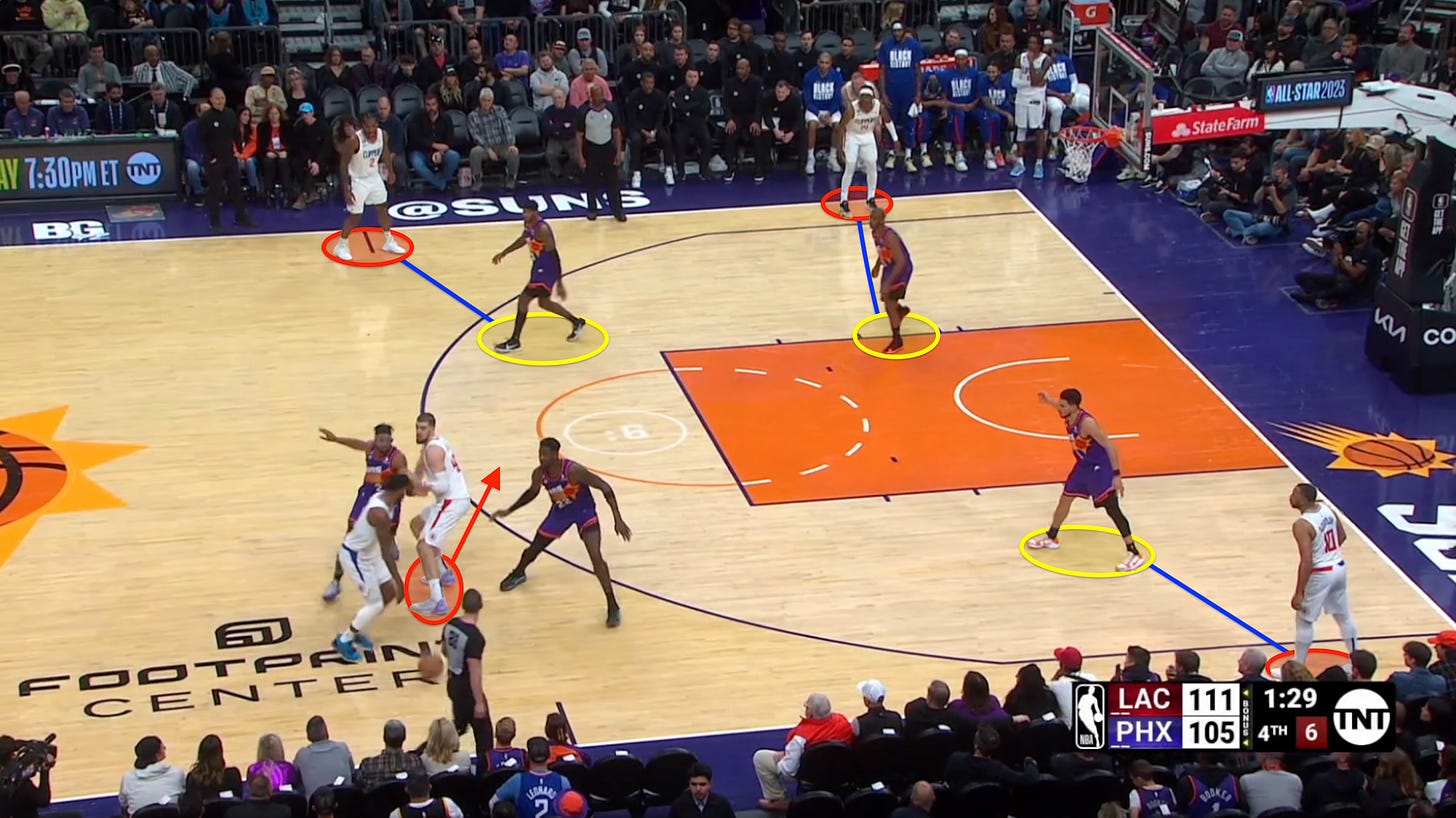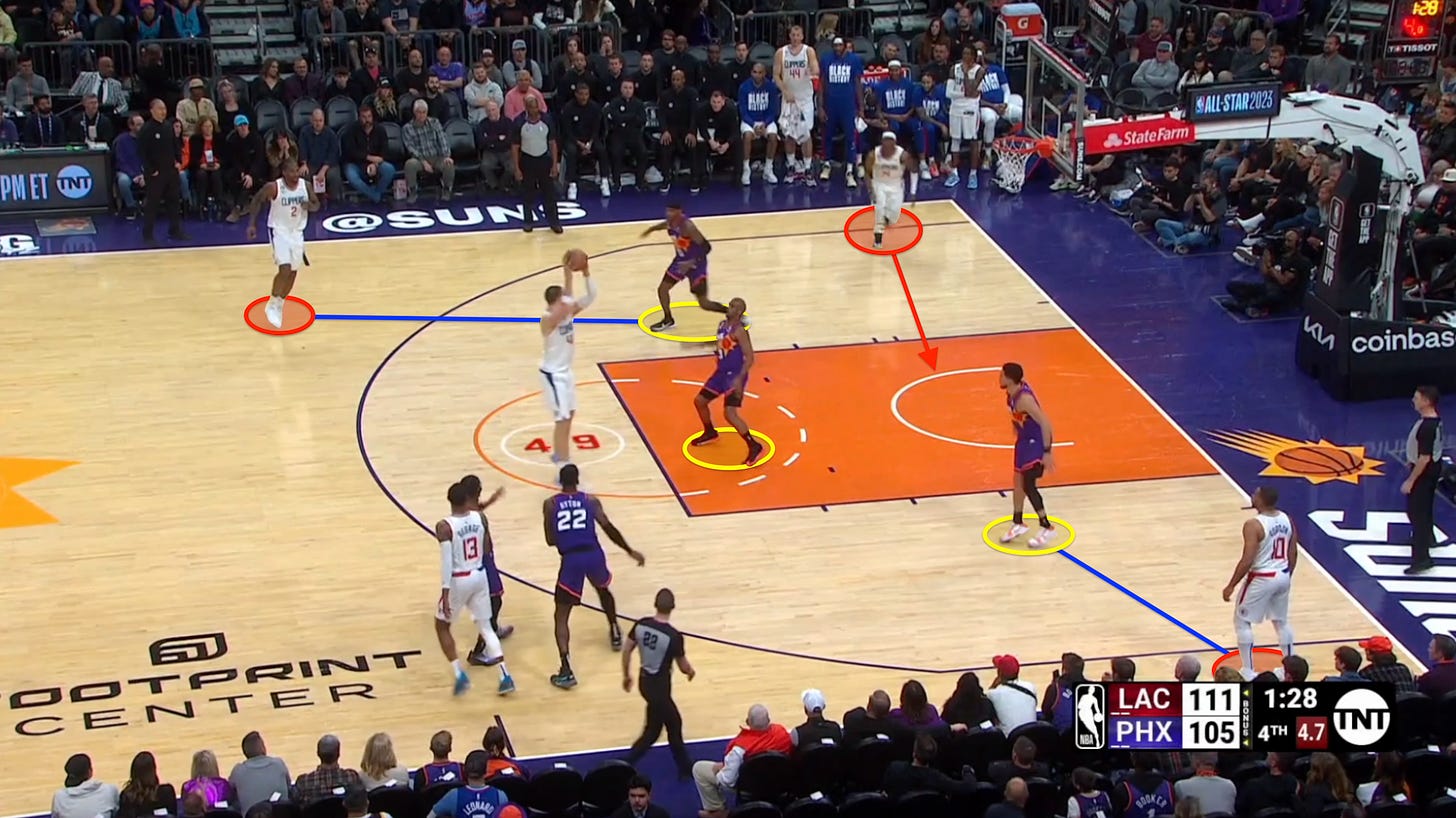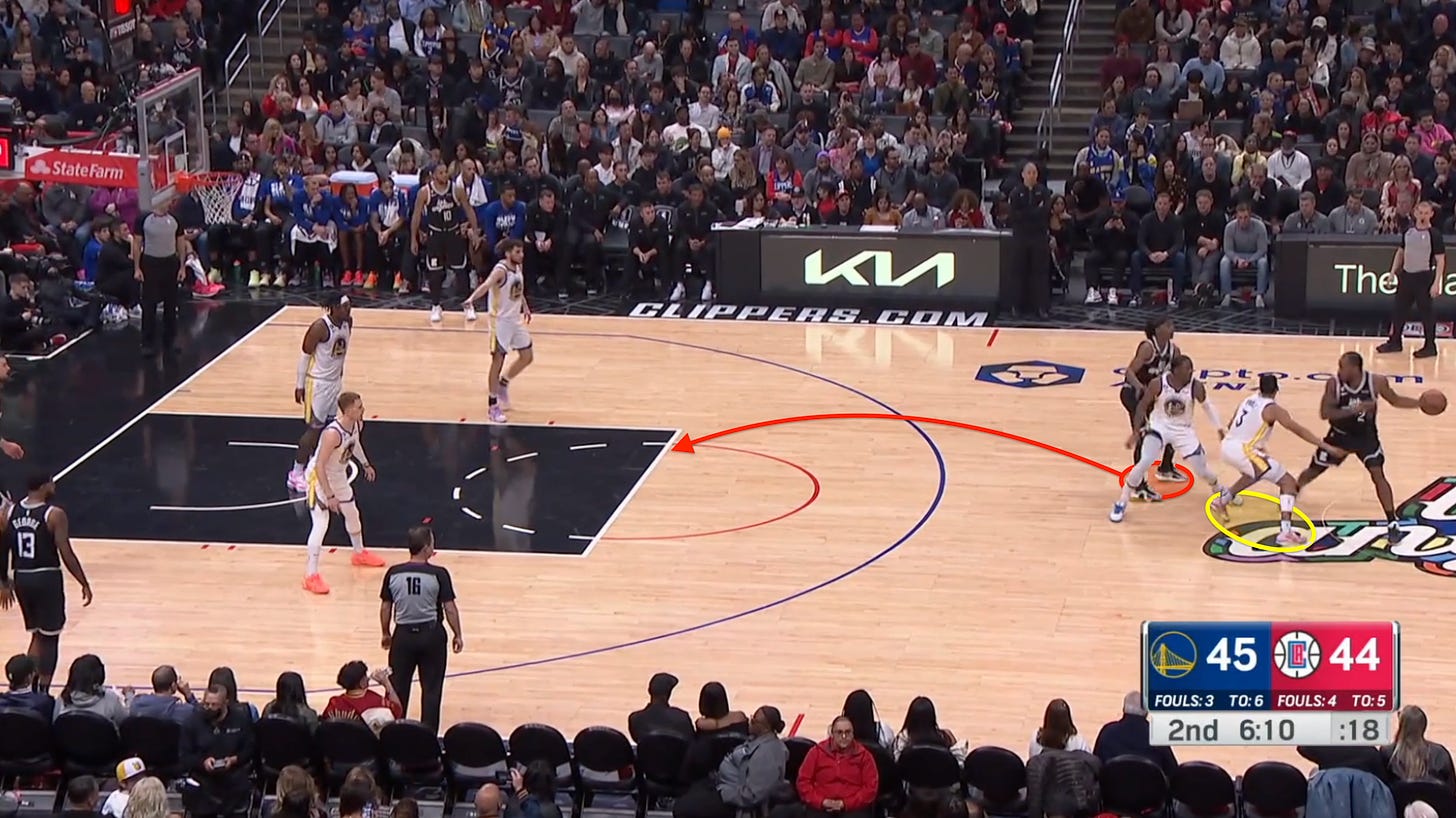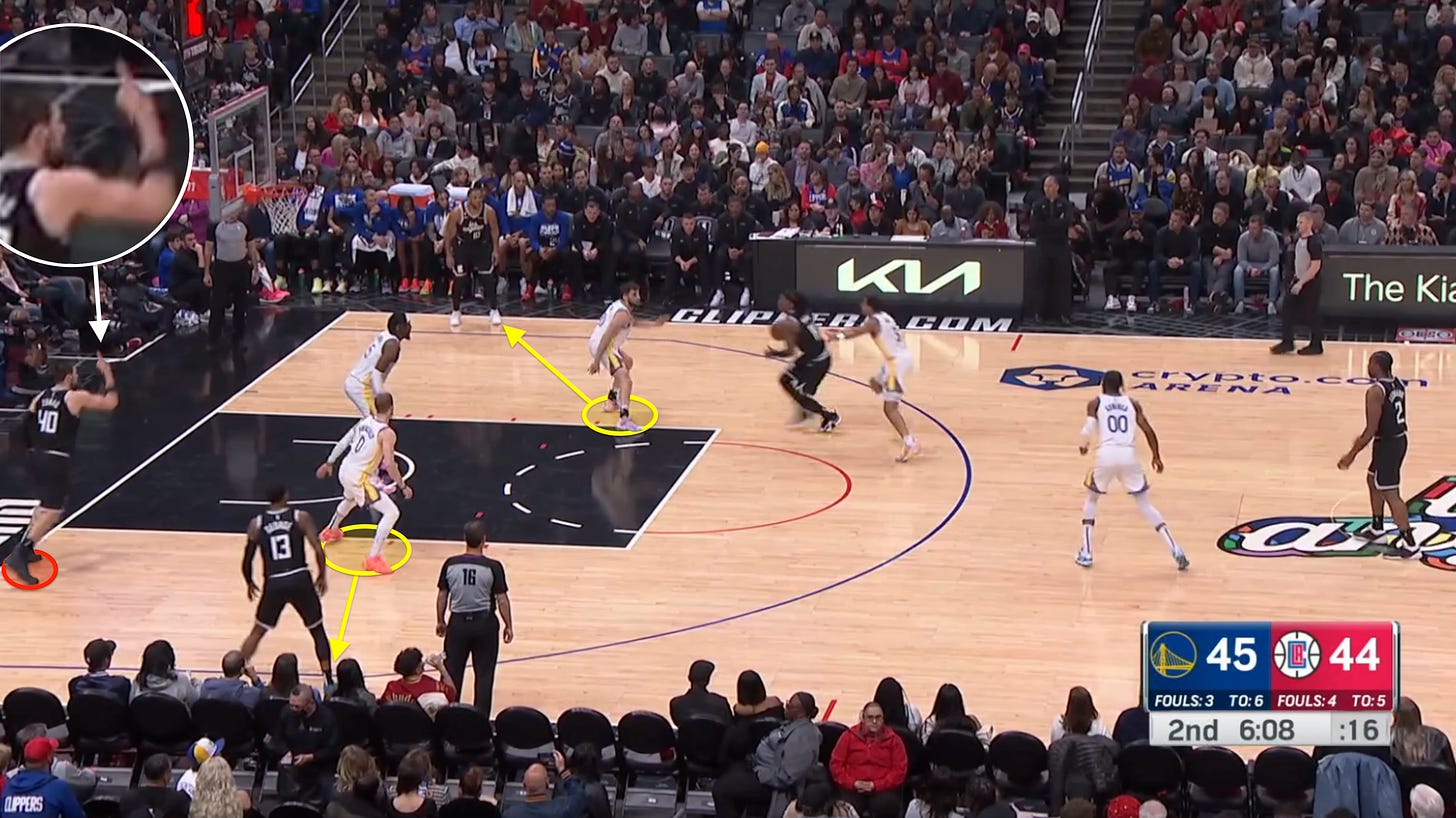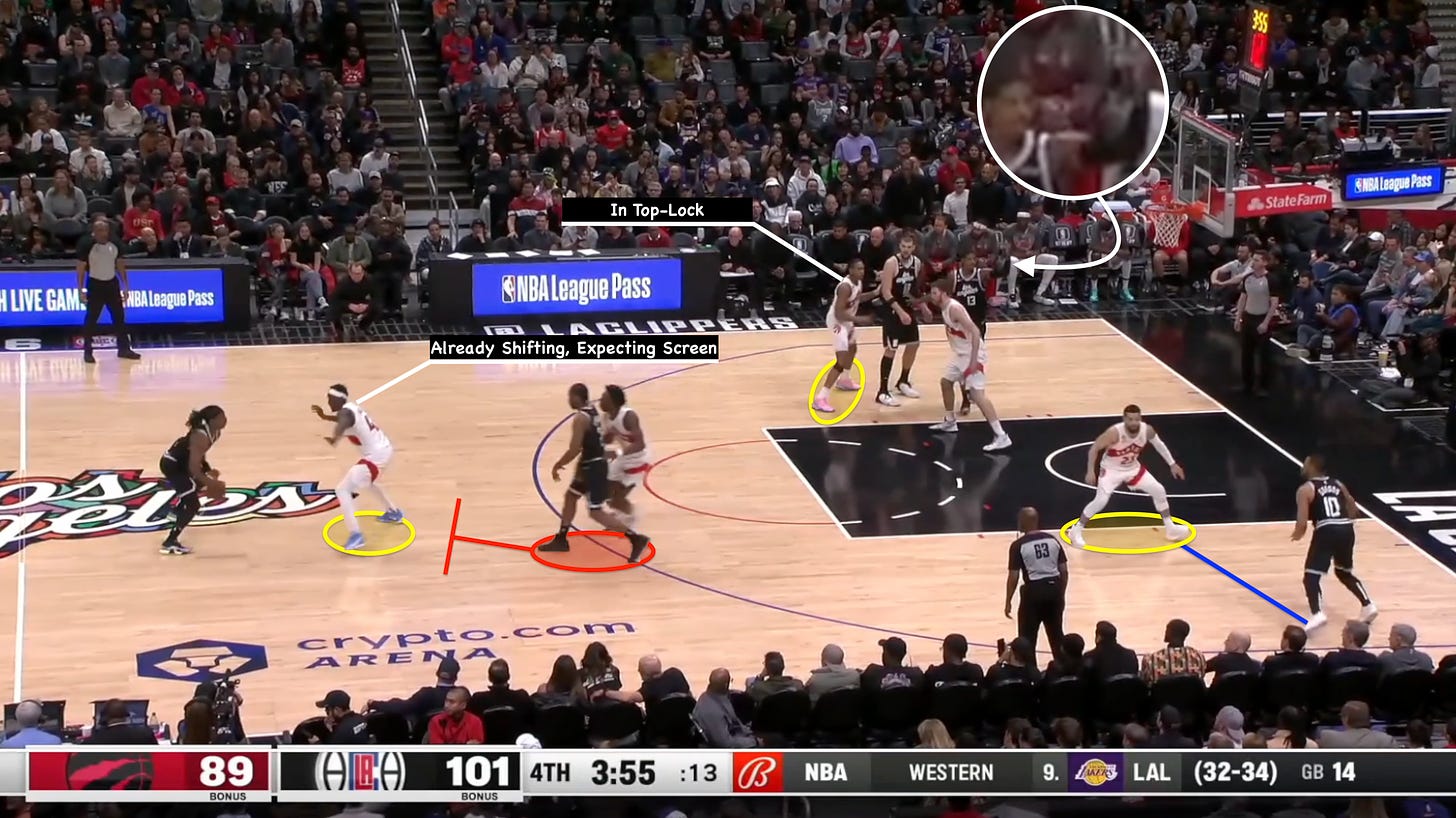We know the simple truth: Kawhi Leonard and Paul George are magnificent players when they play.
When. They. Play.
To that point, the LA Clippers are 56-25 (.691) over the last three seasons in games where both stars suit up. But that’s also the problem: it’s only been 81 games. Eighty-one, out of a possible 236 in the regular season.
That means the Clippers are at “full strength” only 34 percent of the time over the last three years. That impacts a lot. That doesn’t account for games other players on the team miss, but the games that George and Leonard play are what’s important.
This season saw the Clippers unable to reach the heights they hit two seasons ago when they made the franchise’s first-ever Conference Finals appearance. That season, per PBPStats, the Clippers posted a 32-11 (.744) record in games that both George and Leonard played in.
On top of that, the team amassed a plus-9.8 Net Rating in those 43 games. But that all changed this season.
In 2022-23, the Clippers were 24-14 (.632) with a plus-3.5 Net Rating in the 38 games that George and Leonard played together. While that’s still a 52-win pace, it was a far cry from the 61-win pace they posted two years ago.
So, how do you get them back to the level that they were at? Can you even do it? I think you can. It might just take a little tweak of sorts.
The Clippers are a big proponent of small ball — or “long ball” as Clippers president of basketball operations Lawrence Frank classifies it. As a result, the team loaded up on wings who theoretically could play alongside both George and Leonard, but what if the thing that can take the Clippers to the next level is going in the opposite direction?
Now, this isn’t to say that the Clippers need to start playing small all the time with George and Leonard as the four and five, respectively, alongside three guards. A center would still be on the floor with them, but instead of flanking them with a wing and a guard, why not surround the two stars with two guards instead of that additional wing?
“We loaded up with wings to be able to play long ball,” Frank said during his press conference following the Clippers’ dismissal from the 2023 NBA playoffs.
“And some things came to fruition, some didn't. There are reasons why for different things, but you learn along the way of, okay, what's going to be the best group that can surround these guys so we can win a championship next year?”
To that point, according to PBPStats, the Clippers were plus-59 in their 222 “long ball” minutes this season — i.e. when George and Leonard were on the floor without a center. That comes out to a plus-11.4 Net Rating.
But the numbers were also interesting when you factor in the minutes with George and Leonard that were spent without another forward on the floor at all.
As you can see above, the Clippers were a fantastic plus-69 in 192 minutes when George and Leonard played without another forward on the floor. In the end, 185 of the 192 minutes came with a center on the floor. The Clippers were plus-70 during that time, as well.
A lot of that is because of sheer offensive firepower.
Those 185 minutes saw the Clippers put up a 127.2 offensive rating, per PBPStats. They also shot 44.6 percent on three-pointers, and they managed to covert 69.7 percent of their field goal attempts at the rim.
In short: sliding George and Leonard down to the three and four allowed the Clippers to achieve not just a bit more spacing offensively, but also a bit more creativity since most teams had to adjust to who the Clippers had on the floor rather than vice versa.
However, this seems like a good time to bring up the main issue: the problem that the Clippers ran into was that they only got to spend 87 minutes with George and Leonard playing those spots after the trade deadline. And, in those minutes, the team was just plus-14.
That could be for a variety of reasons, chief among them the fact that there was little time to adapt to the new pieces due to injuries and such. Yet the sample size is the sample size and you do have to work off of that.
The main takeaway, at least when parsing through data and film, was just how much the key to their next step might also involve Terance Mann.
After the trade deadline, the trio of George, Leonard, and Mann logged 80 minutes together. The breakdown was as follows:
While plus-16 in 80 minutes does not seem like something significant, it should be noted that in the 262 post-deadline minutes that George and Leonard spent without Mann, they outscored opponents by only 17 points.
In the 55 minutes that Mann got to spend with George, Leonard, and center Ivica Zubac after the trade deadline, the Clippers were plus-21. The team was plus-28 in the 156 minutes that George, Leonard, and Zubac played without Mann.
So, in theory, the Clippers should have four of their starting five set in stone for next season (barring trades of course), with those four spots belonging to George, Leonard, Mann, and Zubac.
That brings about the biggest question: who should be the fifth starter?
Well, that depends. Who returns and who the team adds will be big things to watch this summer, not just as far as this specific lineup is concerned but also just in general.
In the meantime, let’s look at some of the, albeit limited, footage with that group on the floor alongside a guard post-deadline.
This first possession comes from a Feb. 16 game on the road in Phoenix, and it starts with Eric Gordon bringing the ball up the floor. As an aside: you will notice that Gordon is in all of these clips. He was the chosen guard that coach Tyronn Lue put on the floor with this group.
Eventually, the ball is entered into the mid-post to Kawhi Leonard who then turns and faces. The main reason to turn and face the defense here is an obvious one: to see the eventual double-team coming. After all, there’s no reason for Phoenix to let Leonard operate one-on-one against Torrey Craig if they can help themselves.
As the acronym goes: MSEBY (Make Someone Else Beat You).
When Leonard faces up, we see the first indication of how this unit could benefit from the overall spacing they’re afforded.
Devin Booker is helping way down off of Gordon, and Gordon’s unique spacing profile that allows him to hit three-pointers from longer distances than normal pulls Chris Paul down towards the nail and off of Terance Mann on the left wing. Paul has to be ready to help on the next action, which means the Clippers are already primed to put the Suns into rotation.
When the ball finds its way into Gordon’s hands after Leonard passes out of the double, Mann is left uncovered. While Mann did shoot 39 percent on threes this season, and 40 percent on catch-and-shoot triples, the versatile wing still prefers to get downhill to the rim whenever he can.
Mann attacks the hard closeout by Josh Okogie, and because Booker had to navigate back across to the far corner to pick up Okogie’s assignment after Okogie rotated onto Mann, it frees up Mann for a nice gallop down the paint where Ivica Zubac sets a ‘Gortat Screen’ — REMEMBER THE GORTAT SCREEN??? — against Deandre Ayton, thus giving Mann an easy path to a score.
In summary: posting Leonard up forced Phoenix into rotation, as we saw early on with Booker stunting down to force Leonard into giving the ball up. The subsequent string of actions came about as a result of that.
Any time you can force a defense into four rotations such as this, especially with the ball moving from one side of the court to the other, the odds are heavily in your favor to score.
This is something this particular lineup group did very well. They attacked the seams that defenses presented to them, and they did so with great alacrity. That’s another reason this group of players could be successful going forward. There was a great understanding of each other’s skill sets, and a readiness to do the role required of them.
From that same game, we see an instance of what the Clippers can get out of a simple misdirection involving Paul George.
Considering George was a 37 percent three-pointer shooter this season on very high volume, and 38 percent on catch-and-shoot attempts, defenses have to pay attention to him at all times.
In this clip, we see what happens when a defender shoots the gap on what they think is a George cut, and then the defender has to navigate back into what they then perceive as George coming off of a screen where he’ll rise and fire. Except, George makes the instantaneous read to attack the poor closeout, getting downhill for a layup.
But there’s an added underlying wrinkle in this play.
Booker is rooted in the strongside corner and, as a rule of thumb, you never help one pass away, and especially never off of the strongside corner. Therefore, the Clippers parking Gordon there pays off since Booker can’t help on the drive as much as he probably would like to.
It sounds simple, but parking two capable shooters in the corners and operating off of that is a vital key for this group.
This play results in a nice cut from the baseline that leads to a dunk by Mann, but how the Clippers got there has been a staple for the team ever since Lue got the head job three years ago.
While this is a simple sideline-out-of-bounds (SLOB) play, it really starts when the ball finds its way into the hands of Paul George. The Clippers get good spacing by parking Gordon and Mann in the corners and having Leonard on the left wing. It makes it difficult to double off of any of the three.
As a result, Zubac runs up to set a screen for George. Directly after making brief contact on the screen, Zubac turns his hips and begins his roll.
We can see the shift in the hips of Zubac here, and we can see how the other three defenders not involved directly in the action are positioned. They each have to account for a worthwhile offensive player, and that leaves Zubac with a ton of room to roll into.
The key to any good pick-and-roll situation is maximizing the space presented to the roller. The more space the roller has, the more time he has to make an informed decision. The quicker that space gets gobbled up, the likelier it is to result in mistakes. In this instance, however, we see Zubac get a ton of time to make a read.
Because of where Zubac catches the ball, and due to the people flanking him, there’s ample space and time for the big man to make his read.
Chris Paul rotates off of Terance Mann in the corner to meet Zubac at the nail, and Josh Okogie has to stunt between both Mann and Leonard on the wing. Booker can’t even help as much as he wants off of Gordon, either.
This is also where Mann’s smarts and understanding of what he’s supposed to do come into play. Had he stayed rooted in the corner, it makes it easier for both Paul and Okogie to defend. At no point can the offense allow two players to defend three, and Mann’s baseline foray negates that possibility.
Zubac makes the read, Zubac makes the pass, and Mann puts it home.
The lineup put teams into decisions, and whenever you force players to have to make multiple decisions on multiple actions within one play, you start to open up more options. That’s what it’s all about.
This play is a good illustration of why just the threat of these players on the floor matters.
Paul George gets downhill off of a simple Ivica Zubac ball screen at the top, and he comes downhill which forces Jonathan Kuminga to dig down the tiniest bit at the elbow while George’s drive also occupies Kevon Looney in drop coverage.
That split-second decision by Kuminga to dig down allows George to kick out directly to Kawhi Leonard who has more than enough space to rise and fire a three-pointer, which he sinks.
We get a twofer on this one.
Another part of the Clippers’ success over the last couple of years has been their unique ability to use smaller players as screeners in pick-and-roll action. Especially when those players are flanked by other shooters, or with an option to dump it off to a big occupying the dunker spot.
The first play features Mann as the screener for Leonard, and it’s effective because the Warriors are trying everything in their power to get the ball out of Leonard’s hands.
Mann sets a quick screen, and when he rolls he’s given a massive runway to the rim thanks to Kevon Looney still having to be down low to defend against Ivica Zubac.
While Mann does have multiple options to pass to on this play, he goes up strong and finishes through Looney with a nice layup. This is your reminder that Mann shot 72 percent inside the restricted area this season, and those shots made up 40 percent of his total field goal attempts throughout the year.
As we move into the second clip from the previous video, we get started with a very overlooked thing in basketball: the fake motion.
Mann makes an indication to Paul George in the corner almost as if to say, “I’m about to set the pindown, get ready to run off of it.” Instead, what he’s attempting to do is get his defender to hesitate for even the briefest of moments and be late for the actual action that’s about to come.
The next sequence involves Mann running up to set a screen for Leonard. Unlike the first clip where Mann was able to push Kuminga and turn the corner to the middle of the floor, this time we see the Warriors attempt to hedge with Jordan Poole so that Leonard has to delay his pass.
The problem with what happens here is that Mann is still able to get to the middle of the floor as a result of the pass, simply because Poole has to navigate too much space to deny Mann the ball.
Mann does a good enough job of pinning Kuminga further up the floor and propels himself wide to the wing to give Leonard room to deliver the pass.
This puts Mann downhill with the ball in his hands, just like in the previous clip.
As Mann dribbles down the lane, we get a great glimpse into the level of decisions that this lineup can force the opposition to make.
Ty Jerome stunts briefly off of Eric Gordon in the strongside corner, but he knows he has to retreat back to Gordon because of the threat the guard provides. Additionally, Donte DiVincenzo stunts down on the weakside but, like Jerome, has to jump back out to Paul George in the corner because of the threat that George presents.
With Mann coming downhill toward the rim, Kevon Looney feels forced to step up to negate any attempt at a layup. Considering what happened just one possession before, this makes a lot of sense. That’s where Zubac comes into play.
Zubac is camped in the dunker spot, and we do see him motion to Mann to throw the lob. Mann obliges, Zubac dunks it, and the Clippers have reaped massive rewards on back-to-back possessions.
It’s really that simple.
The Clippers run a high ball-screen for George on this play, and as George comes downhill off the Zubac screen, he snakes back to the middle of the floor before pulling the ball back out.
However, before Fred Van Vleet can fully recover, George speeds down the paint, receives a “Gortat Screen” from Zubac, and lays it in. Yet please keep an eye on what’s happening in the strongside corner.
Due to the threat of Leonard in that corner, OG Anunoby, who did finish on the NBA All-Defensive Second Team, is a tad late to help on the drive by George, and the result is a layup.
There’s no great analysis for this play up above other than to watch the looks that the Clippers can generate because of the attention that Leonard draws, the hustle that Mann brings on the offensive glass, and the overall spacing afforded to all of the players due to how they all work in harmony.
But there is one last play to look at:
I love this play because of its simplicity, and because of how much it shows the growth of Mann specifically, as well as the threat of others.
When Mann is operating as the ball-handler, Leonard walks up to set a ball screen. You can see Pascal Siakam switch his hips to try and jump out to ICE the screen and force Mann away from it.
In the meantime, Scottie Barnes is in top-lock against Paul George, attempting to deny George any attempt at coming off of a pindown from Ivica Zubac. Meanwhile, Van Vleet is locked into face-guarding Gordon in the nearside corner.
A fun element of this is George motioning for Gordon to run off of staggered screens that both George and Zubac are in the process of getting ready to set. This also adds to why sets like this can be dangerous for a defense.
As has been the theme in a lot of these clips, whenever you can get a defense to pay attention to multiple actions being run on the same play, you, as an offense, are in firm control of your possession-by-possession destiny.
Mann goes early, right as Siakam flips his hips to ICE the screen. As a result, Siakam is out of position guarding the ball, and Mann gets a nice lane down to the paint for an easy finish at the rim thanks to Barnes and Van Vleet not having their eyes in on the play due to guarding viable perimeter threats.
Jakub Poeltl could have probably had a better contest at the rim here on this play, but the threat of a dump-off to Zubac could be reason enough to delay the help from arriving in time.
Either way, this group made a lot of good things happen on the offensive end. This isn’t to say this is the only lineup that should ever play for the Clippers next season. That’d be foolish as hell.
Instead, it’s to highlight and illustrate just how good this group could potentially be, or even the skeleton of that group in general.
In total, this group — George, Gordon, Leonard, Mann, and Zubac — logged 42 offensive possessions, according to PBPStats, and scored 59 points during that time. That comes out to a ridiculous 140.5 offensive rating.
However, they only got time against four teams — Golden State Warriors (twice), Phoenix Suns, and Toronto Raptors. All three teams ranked in the top half of the league in defensive rating. Only two of those four games came after February, and due to George’s eventual season-ending injury, they didn’t log any time after Mar. 21.
It does feel like the best pathway forward for the Clippers is to use the threat of George and Leonard a lot more than they did this season.
That’s not to say that the two stars should be moved into more of a decoy role next season, but rather to accentuate the talent and impact of those around them, they need to be on the floor with players like Mann who can thrive on the margins as a ball-handler, floor spacer, and cutter.
There are going to be some tough decisions made by the front office this offseason, but a very easy one should be to have George and Leonard embrace the three and four more often. It benefits everyone on the team.
It’s been time for a while, and there’s no more time to waste.
Reminder: All content in May and June is completely free for former Patreon subscribers that have made the journey to Substack, and all content in May will be completely free for all readers in general.









